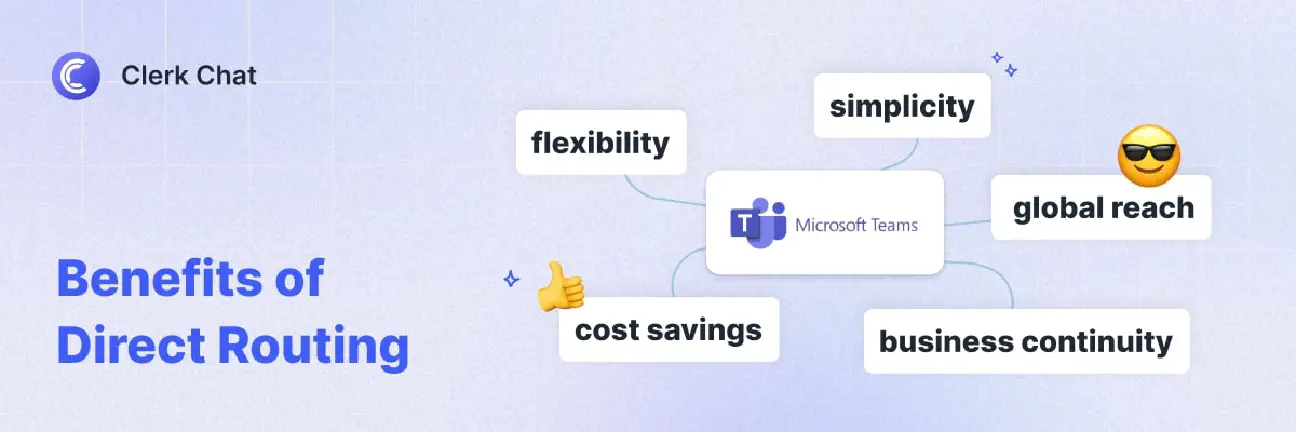Direct Routing vs Operator Connect: The Ultimate Guide
By Team Clerk Chat
- Published: September 27, 2024
Direct Routing vs Operator Connect: What’s the difference, and how do you choose the method for adding business phone functionality to Microsoft Teams?
On the surface, Operator Connect and Direct Routing seem pretty similar. They both give you a way to connect Microsoft Teams, one of the world’s most popular productivity and collaboration apps, to the PSTN (Public Switched Telephone Network).
Both options allow you to choose the carrier you want to use for porting a phone number to Teams, or accessing calling features within Teams. They also both use similar technologies, like SBCs (Session Border Controllers) and SIP trunks.
However, there are some major differences to consider when you’re assessing the right option for your specific needs. Here’s your complete guide to Teams Direct Routing vs Operator Connect.
Direct Routing vs Operator Connect: The Basics
Microsoft Teams, one of the most popular productivity tools in the world (with over 320 million monthly active users), comes packed with plenty of powerful features for video and voice conferencing, chat, file sharing, and more.
However, if you want to access phone services within Microsoft Teams, such as the ability to leverage Microsoft Teams SMS and calling, you’ll need to link the application with a PSTN.
Microsoft has its own Business Calling plans to enable this, but they’re not the right choice for every business. Microsoft Calling plans aren’t available in all regions worldwide, and they don’t offer access to certain advanced features, like VoIP text messaging, as standard.
Direct Routing and Operator Connect allow companies to choose from a range of carriers who can enable PSTN connectivity within Microsoft Teams. These partners integrate their services with Microsoft’s Phone Systems, using SBCs and SIP trunking capabilities.
Direct Routing for Microsoft Teams was the first option Microsoft introduced to give companies the freedom to leverage their own carrier within Teams. Virtually any voice provider can offer this service, even if they haven’t been certified by Microsoft.
Operator Connect, introduced at a later stage by Microsoft, gives companies access to a similar, though slightly less flexible alternative. With Operator Connect, companies can work with approved third-party companies, like Verizon Mobile for Microsoft Teams, and manage their ecosystem from within the Teams admin interface.


What is Direct Routing for Microsoft Teams?
Direct Routing is a means of linking Microsoft Teams to a PSTN, so users can make and receive calls through the Teams client. Some direct routing providers can also enable access to business SMS solutions, giving users even more ways to communicate through Teams.
Plus, this solution also enables organizations to link Teams to other legacy hardware, such as analog devices, door phones, alarms, and emergency phones. A carrier offering Direct Routing will take advantage of a Session Border Controller (SBC) to establish a connection between their telephony infrastructure and Microsoft Teams.
This SBC can convert various media and signalling services so that businesses can connect all of their new and existing communication tools in one ecosystem.
Compared to Operator Connect, Direct Routing generally offers more flexibility. You can use SIP trunks from various carriers around the world to build a holistic communications strategy and access a range of customized services and features.
However, Direct Routing is also more complicated to configure and manage than an Operator Connect service. It usually requires you to manage your own SBC, unless you’re working with a Direct Routing as a Service provider. Plus, you’ll need a knowledge of PowerShell to configure and provision numbers and services to users.
The Benefits of Direct Routing for Microsoft Teams
In the comparison of Direct Routing vs Operator Connect, Direct Routing might be a more complicated option, but it also gives you a lot of flexibility. Almost any telecom carrier can configure and deploy a Direct Routing service, anywhere in the world.
Plus, your provider can configure solutions for a range of use cases. For instance, you can access contact center services through Direct Routing for customer service messaging and calling.
Direct Routing also gives users:
- More control over numbers: With Direct Routing, you can hold onto your existing dial plan and any numbers you’ve purchased from your carrier. Plus, you’ll be able to use various cloud providers to route your calls to various systems.
- Geographic reach: Similar to Operator Connect, Direct Routing ensures you can access calling features in more regions than Microsoft’s calling plans. Since Direct Routing doesn’t require an agreement with Microsoft, you get more global flexibility.
- Versatility: Direct Routing allows you to connect all existing legacy devices and phone systems to Microsoft Teams. You’ll be able to deploy your system in a range of diverse environments, and adapt your functionality to suit your specific requirements.
- Business continuity: Microsoft’s Survivable Branch Appliance is available with Direct Routing, which gives you a local survivability option if Microsoft’s cloud system doesn’t work as it should. This reduces the risk of missing out on crucial calls.
The biggest downside to Direct Routing vs Operator Connect is that Direct Routing is more complex and expensive to implement. You’ll need a Teams Phone license, an SBC, and a deep knowledge of PowerShell to configure and manage your ecosystem.
You’ll also be mostly responsible for installing and managing your own equipment, which can be difficult if you don’t have a huge technical team available to you.

What is Microsoft Teams Operator Connect?
So, what is Operator Connect? Simply put, Operator Connect is an alternative to Direct Routing introduced in 2022. It simplifies the process of connecting your Microsoft Teams application to a phone and texting service for small business or enterprise environments.
Operator Connect is a provider-based service, which involves a carrier doing more of the configuration work for you than they would in a Direct Routing instance. Telecommunications leaders sign contracts with Microsoft to be “certified” for MS Teams Operator Connect.
Once you choose an Operator from Microsoft’s list, they’ll set up a PSTN connection for you, and you can manage your services through the Microsoft Teams admin center. You’ll pay for your service based on what you use (minutes and features), rather than paying on a per-user basis.
When it comes to Operator Connect vs Direct Routing, Operator Connect is considered the simpler, more convenient option. You can take advantage of a managed service format, which means you don’t have to handle SBC configuration or PowerShell commands yourself.
The Benefits of Operator Connect for Microsoft Teams
Operator Connect gives companies access to most of the same benefits as Direct Routing. Depending on the operator you choose, you can still access comprehensive telephony features on a global scale, as well as two-way text messaging and contact center capabilities.
However, you won’t be responsible for installing and managing your own SBCs, and you’ll be able to assign numbers and features to users from within the Teams admin center. The main benefits of Operator Connect for Microsoft Teams include:
- Simplicity: With Operator Connect, purchasing or porting numbers or assigning features to users only takes a few minutes. You don’t need any PowerShell experience, and there’s no need to deal with complex configurations alone.
- Streamlined management: With Operator Connect, your SBC solutions and PSTN calling options are managed by an operator. All you need to do is decide who you want to assign specific features and numbers to in your team.
- Reduced costs: Because your operator handles your SBC solutions for you, there are fewer costs involved with purchasing and maintaining equipment. You may still need expert support for help with things like SMS integrations and upgrades from time to time, but the overall operational costs should be lower.
The biggest downside to Operator Connect vs Direct Routing is that you’ll have less flexibility. First, while virtually any carrier can offer Direct Routing services, Operator Connect providers need to be certified by Microsoft. This can leave you with fewer carriers to choose from.
Additionally, because Operator Connect is a cloud-to-cloud solution, you can’t connect as many legacy solutions to your communications ecosystem. Although SIP gateways can enable the integration of some equipment, you will have fewer options.

Direct Routing vs Operator Connect: Key Differences
Direct Routing and Operator Connect have a lot of similarities. They can both enable access to MS Teams SMS and calling features. They also both use SBCs, and give you more control over your phone numbers, business phone functionality, and global reach.
However, Direct Routing can be a better option for companies that want a more flexible, customizable communications environment. It’s a more accessible option that any telecom provider can take advantage of. Plus, it supports more integrations with legacy hardware and phone systems, as well as stronger local survivability options.
Direct Routing is:
- The more flexible and customizable calling solution for companies with advanced or complicated requirements.
- Available from a wider range of providers all over the world.
- Often more reliable, due to the connection with local survivability solutions.
- More complicated to configure and manage with PowerShell.
- Sometimes more expensive, depending on the hardware and support you need.
Alternatively, Operator Connect is usually the better option if you’re looking for a simple way to add voice and SMS to Microsoft Teams. It’s not available from as many vendors, but still offers excellent global reach and flexibility. You also don’t need any coding knowledge, and don’t have to rely on PowerShell to manage your ecosystem.
Operator Connect is:
- Available from fewer providers than Direct Routing. All Operator Connect providers need to be approved and certified by Microsoft.
- Convenient and straightforward, requiring no PowerShell or coding knowledge.
- Less expensive for most companies, as you won’t need to deploy your own SBCs.
- Ideal for companies with minimal advanced requirements.
- Flexible enough to support a range of communications needs.


Direct Routing vs Operator Connect: Which Is Best?
Ultimately, the decision of whether to use Operator Connect or Direct Routing for your Microsoft Teams communication needs will depend on your specific requirements. Both solutions offer an excellent way to add telephony capabilities to Microsoft Teams.
Typically, Operator Connect is the simpler option, perfect for companies who want to manage all of their phone numbers and features from the Teams admin interface. Alternatively, with Direct Routing, you can access more flexibility and customization options.
With a vendor like Clerk Chat, you have the freedom to choose between both Direct Routing and Operator Connect for Microsoft Teams. As a Microsoft Partner, we can add voice and SMS functionality to your productivity app, and provide access to a range of advanced features.
For instance, with Clerk Chat, you can upgrade Microsoft Teams with AI-powered text messaging capabilities, voicemail, VoIP functionality, and more. We even offer in-depth insights into crucial metrics to help you optimize and improve how you manage your resources.
Plus, with Clerk Chat, you can connect both Microsoft Teams and your SMS services to the applications and tools you already use, such as Microsoft Dynamics, and Microsoft Purview for data compliance and eDiscovery.
Contact Clerk Chat today to learn more about how we can bring advanced telephony features and SMS capabilities to your Microsoft Teams service.
In this article:
- Direct Routing vs Operator Connect: The Basics
- What is Direct Routing for Microsoft Teams?
- The Benefits of Direct Routing for Microsoft Teams
- What is Microsoft Teams Operator Connect?
- The Benefits of Operator Connect for Microsoft Teams
- Direct Routing vs Operator Connect: Key Differences
- Direct Routing vs Operator Connect: Which Is Best?
Ready to use your business number for text messaging?
Thousands of businesses are already experiencing the power of conversational messaging through SMS. Join us. Free trial and paid tiers available.
Get Started#Subscribe
Get product updates in your inbox
Tutorials, features, and Clerk Chat news delivered straight to you.




